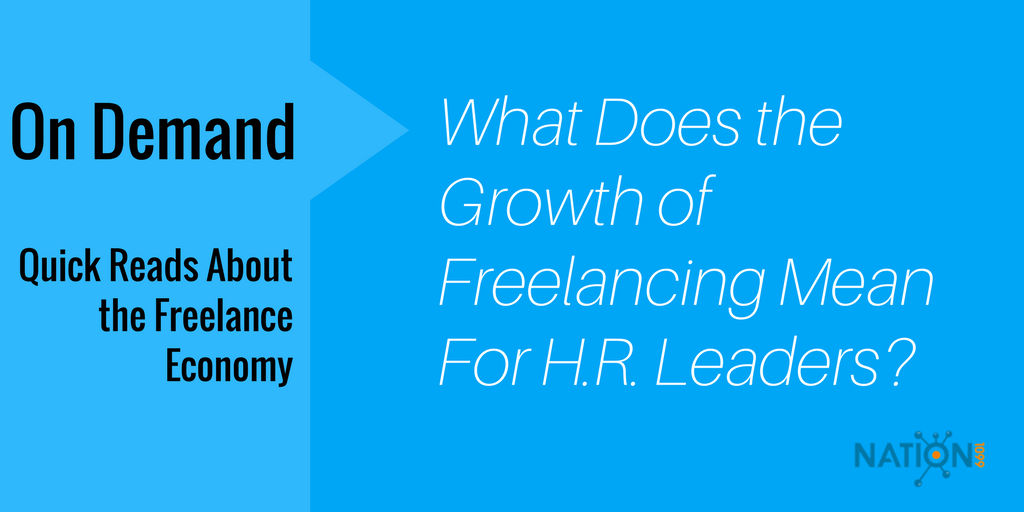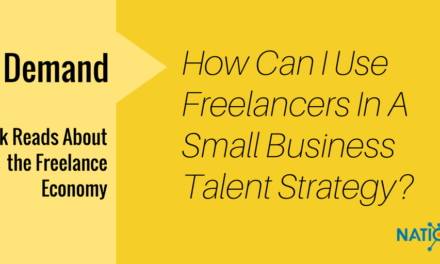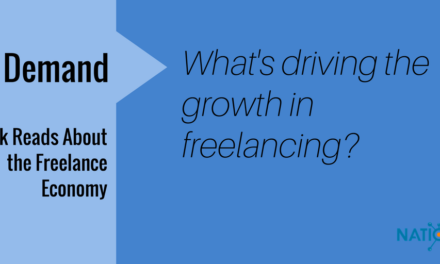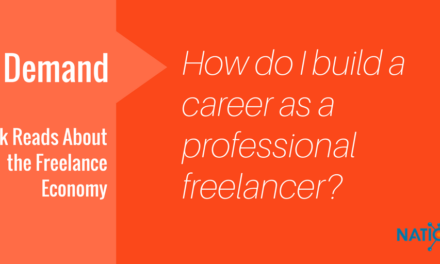What are the H.R. implications of the growth in the freelance and independent contractor workforce? We won’t get into the compliance, classification, legal and purchasing implications for human resources and talent professionals. Let’s just consider what the rise of freelancing means for your talent strategy.
First a few basic stats about the growing freelance workforce.
- 11 percent of the workforce is full-time freelance.
- More than 80 percent say they strongly prefer that way of working.
- More than 50 percent say they wouldn’t go back to traditional employment at any price.
That means 1 in 9 of the potential talent pool isn’t interested in your W-2 role.
It also means your biggest single competitor for talent isn’t another employer; it’s self employment.
If your HR systems are only thinking in terms of W-2s, you are going to miss a significant part of the talent pool.
But nimble companies that can tap into 1099s effectively can out compete other companies in a talent war.
You have to source this talent, of course, but finding freelance talent is the easy part. There are a million marketplaces where you can hire freelancers. A new one gets sent to us every day. (There is a risk of dilution of the talent across underwhelming freelance marketplaces, so it we’re watching for innovation technology solutions and for business innovations in this area in our freelance trend watch newsletter.)
Once you do source freelance talent, it’s much harder to get good value out of that relationship.
Most freelancers will tell you that most of their clients don’t work with them effectively. Clients hold us at arm’s length. Their onboarding for contingent workers is non-existent. They lose our invoices. They don’t tell us the mission of the company, the values of the company or the strategy we’re supposed to aligning our work around.
This is a huge waste of the value of freelance professionals. It’s crazy. On the one hand, companies have complicated systems to track progress on and improve on metrics like quality of hire. On the other hand, the customary way of working with freelancers seems purposely designed to leave value on the table.
The H.R. implications are significant. These are mistakes that H.R. can have a key role in correcting.
If your company has a talent strategy that only accounts for W-2 workers and a mess of accidental and unwritten policies for their 1099s, then you also have a big opportunity for improvement. If you do this well, then you can differentiate your company from your competitors.
H.R. leaders should assume that the “employer of choice” will also need to become a “client of choice.”
Getting better at working with 1099s means thinking through the recruitment, onboarding and ongoing engagement of this workforce.
Ongoing engagement? That’s for employees, isn’t it?
Wrong attitude. Remember, project-based shouldn’t mean disposable. If you are holding your 1099s at arms length, then you are optimizing for flexibility.
Flexibility is the least interesting thing about the growth of the freelance workforce. Engagement, passion and highly directed skills is the strategic opportunity for H.R. leaders.
Don’t optimize for flexibility. Optimize for value. H.R. leaders should be leading that conversation in their companies.
H.R. leaders should also consider what the growing gig economy tells you about traditional employment. You can assume that every committed freelancer is a former W-2 at a company whose employee retention efforts failed.
In fact, you can assume that 1 in 9 of your former employees is full-time freelance. Is there any single employer who has absorbed 11 percent of your former employees? If not, that means freelancing is the single strongest countervailing force to your employee retention.
Surveys show over and over that freelancers leave W-2 life because of low engagement, poor flexible work policies and a work/life balance that is tipping the wrong direction. The more freelancing grows, the more H.R. leaders know that employment is becoming less desirable.
And the freelance population is booming. The total freelance workforce is projected to grow by 3.5 percent per year. Where do they come from?
Presumably from the 25 percent of the workforce that is primarily W-2 right now but part-time freelance or side hustling in some way. Your employees who are side hustling are learning the ropes of freelancing, and some of them will be the refugees fleeing W-2landia to Nation1099.
The good news here is that updating your H.R. and talent policies to work effectively with freelancers will pay dividends with your employees also.
For example, getting better at remote work is going to be inevitable, because hiring 1099s is going to be inevitable. Which means you can apply what you’re learning to their W-2 peers.










